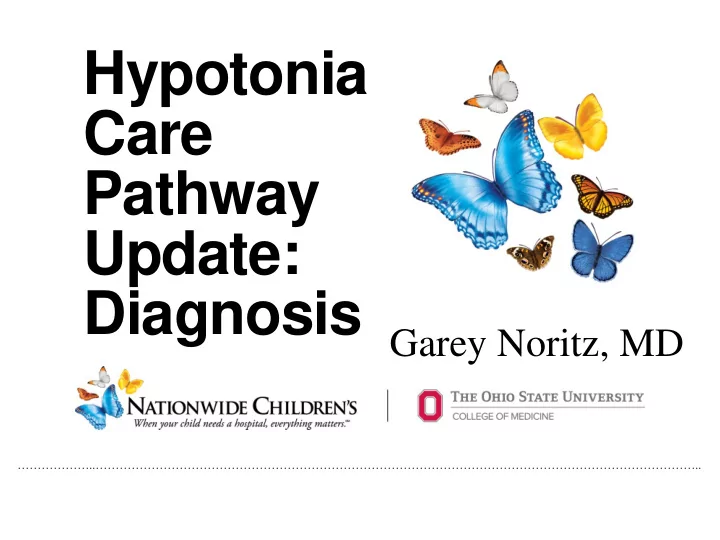

Hypotonia Care Pathway Update: Diagnosis Garey Noritz, MD ………………..……………………………………………………………………………………………………………………………………..
Disclosure Information- AACPDM 72 nd Annual Meeting | October 9-13, 2018 Speaker Name: Garey Noritz, MD Disclosure of Relevant Financial Relationships I have no financial relationships to disclose. Disclosure of Off-Label and/or investigative uses : I will not discuss off label use and/or investigational use in my presentation ………………..……………………………………………………………………………………………………………………………………..
Apkon S, Noritz G. Developmental Medicine & Child Neurology. 2018;60(9):851 ………………..……………………………………………………………………………………………………………………………………..
Ciafaloni E, et al. The Journal of Pediatrics. 2009;155(3):380-5. Mean Age First Signs or Symptoms Noted 2.5 years First reported to PCP 3.6 years First Creatine Kinase Sent 4.7 years Definitive Diagnosis of Duchenne 4.9 years 156 boys without a family history of Duchenne (2009) ………………..…………………………………………………………………………………………………………………………………….. 156
Why is early diagnosis important? • Early identification of CP can improve outcomes by intervening during the early period of neuroplasticity • Even incurable disorders, including many neuromuscular disorders, are treatable. • A delay in diagnosis delays access to information about care options, relevant clinical trials, and support networks for a specific disorder. • Not having an accurate diagnosis may result in a child missing appropriate therapies or receiving therapies not recommended for a disorder. • Delays in diagnosis often impede access to services, including Early Intervention and other health care services. • Early diagnosis facilitates access to genetic counseling to learn about family planning options. • There can be significant family stress with the delay of an accurate diagnosis. Families often see several clinicians before receiving a referral to a specialist familiar with neuromuscular disorders and may experience unnecessary testing. ………………..……………………………………………………………………………………………………………………………………..
………………..……………………………………………………………………………………………………………………………………..
………………..……………………………………………………………………………………………………………………………………..
………………..……………………………………………………………………………………………………………………………………..
………………..……………………………………………………………………………………………………………………………………..
………………..……………………………………………………………………………………………………………………………………..
Key Components of the Neurological Exam • History, Developmental Milestones • Weight, Height, Head Circumference on Appropriate Growth Charts • Dysmorphic Features • Signs of Respiratory Distress • Organomegaly • Strength Testing by Functional Observation • Fasciculations, Primitive, and Deep Tendon Reflexes • Muscle Bulk and Tone ………………..……………………………………………………………………………………………………………………………………..
Testing for Tone Popliteal Angle IMPLICATIONS SCARF SIGN POPLITEAL ANGLE The elbow position is 5 ° age 1-3 years Suspect normal tone. between the bilateral Scarf Sign 15-25 ° age 4 years midclavicular lines. 25 ° > 5 years The elbow crosses the <5 ° > 1 year of age Suspect low tone. midline to the contralateral midlclavicular line The elbow does not cross the >25 ° > 1 year of age Suspect high tone. ipsilateral midclavicular line. ………………..……………………………………………………………………………………………………………………………………..
Localize the Problem Sign Upper Motor Lower Motor Muscle Neuron Neuron Atrophy None Severe None Fasciculations None Common None Tone Spastic Decreased Normal or Decreased DTRs Hyper Hypo Normal or Hypoactive Babinski Up Down Down Test MRI SMN Testing CK
Testing for a child with Low (or Normal) Tone • Creatine Kinase (CK): • The CK is significantly elevated in Duchenne Muscular Dystrophy, at least 3x normal. Often elevated in other muscle diseases • Ohio Medicaid Max Payment (2018): $6.70 • Thyroid Stimulating Hormone (TSH): • Thyroid myopathy may present with either hypothyroidism or hyperthyroidism, or without classical signs of thyroid disease (admittedly uncommon) • Ohio Medicaid Max Payment (2018): $17.29 • Microarray: around $2200 (2014) ………………..……………………………………………………………………………………………………………………………………..
* Pediatric Neurology. 2002;26(5):383-6. 1. Early Hypotonia, usually since birth 2. Active movements of the limbs and normal tendon reflexes 3. Normal or mild motor delay that improves later on 4. Normal muscle enzymes 5. Normal Electromyogram and Nerve Conduction Velocities 6. Normal Muscle Biopsy I would add: 1. Absence of encephalopathy *Previously: Benign congenital 2. Absence of other congenital anomalies hypotonia, etc. ………………..……………………………………………………………………………………………………………………………………..
Developmental Medicine & Child Neurology. 2011;53(7):586-99. Hypotonia has been described as a feature of more than 500 genetic disorders… and counting. ………………..……………………………………………………………………………………………………………………………………..
………………..……………………………………………………………………………………………………………………………………..
What about Hypotonic Cerebral Palsy? Developmental Medicine & Child Neurology. 2014;56(4):323-8. ………………..……………………………………………………………………………………………………………………………………..
What about Hypotonic Cerebral Palsy? Dev Med Child Neurol Suppl. 2007;109:8-14. ………………..……………………………………………………………………………………………………………………………………..
What about Hypotonic Cerebral Palsy? ………………..……………………………………………………………………………………………………………………………………..
Regardless of Suspected Diagnosis… ………………..……………………………………………………………………………………………………………………………………..
References • Apkon S, Noritz G. The primary care pediatrician: key to improving neuromotor outcomes. Developmental Medicine & Child Neurology. 2018;60(9):851. • Carboni P, Pisani F, Crescenzi A, Villani C. Congenital hypotonia with favorable outcome. Pediatric Neurology. 2002;26(5):383-6. • Ciafaloni E, Fox DJ, Pandya S, Westfield CP, Puzhankara S, Romitti PA, et al. Delayed Diagnosis in Duchenne Muscular Dystrophy: Data from the Muscular Dystrophy Surveillance, Tracking, and Research Network (MD STARnet). The Journal of Pediatrics. 2009;155(3):380-5. • Lisi EC, Cohn RD. Genetic evaluation of the pediatric patient with hypotonia: perspective from a hypotonia specialty clinic and review of the literature. Developmental Medicine & Child Neurology. 2011;53(7):586-99. • Noritz GH, Murphy NA. Motor delays: early identification and evaluation. Pediatrics. 2013;131(6):e2016-27. • Rosenbaum P, Paneth N, Leviton A, Goldstein M, Bax M, Damiano D, et al. A report: the definition and classification of cerebral palsy April 2006. Dev Med Child Neurol Suppl. 2007;109:8-14. • Smithers-Sheedy H, Badawi N, Blair E, Cans C, Himmelmann K, Krägeloh-Mann I, et al. What constitutes cerebral palsy in the twenty-first century? Developmental Medicine & Child Neurology. 2014;56(4):323-8. ………………..……………………………………………………………………………………………………………………………………..
Recommend
More recommend